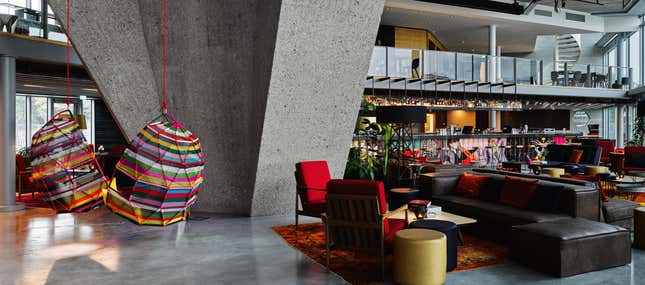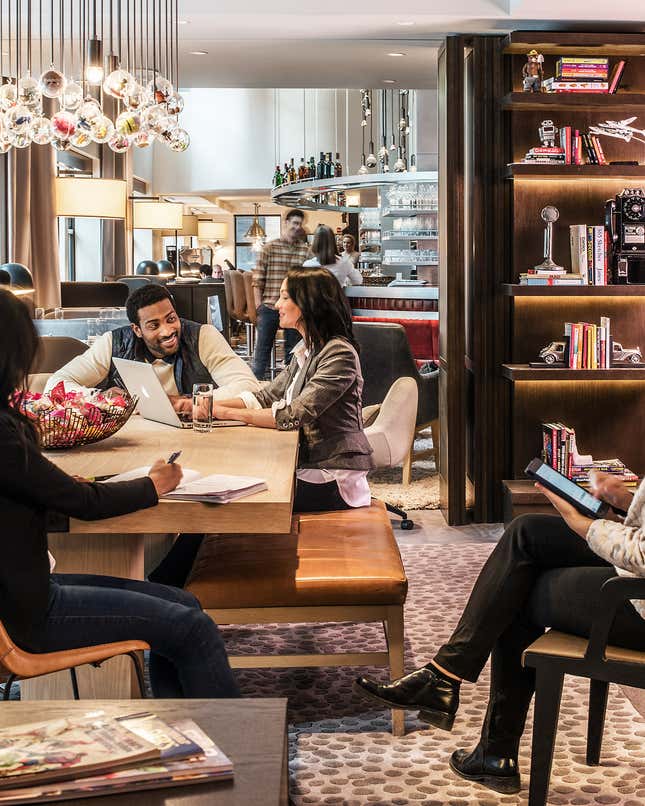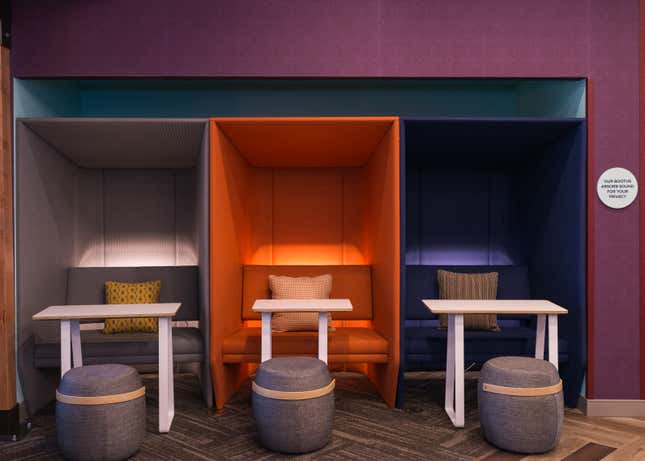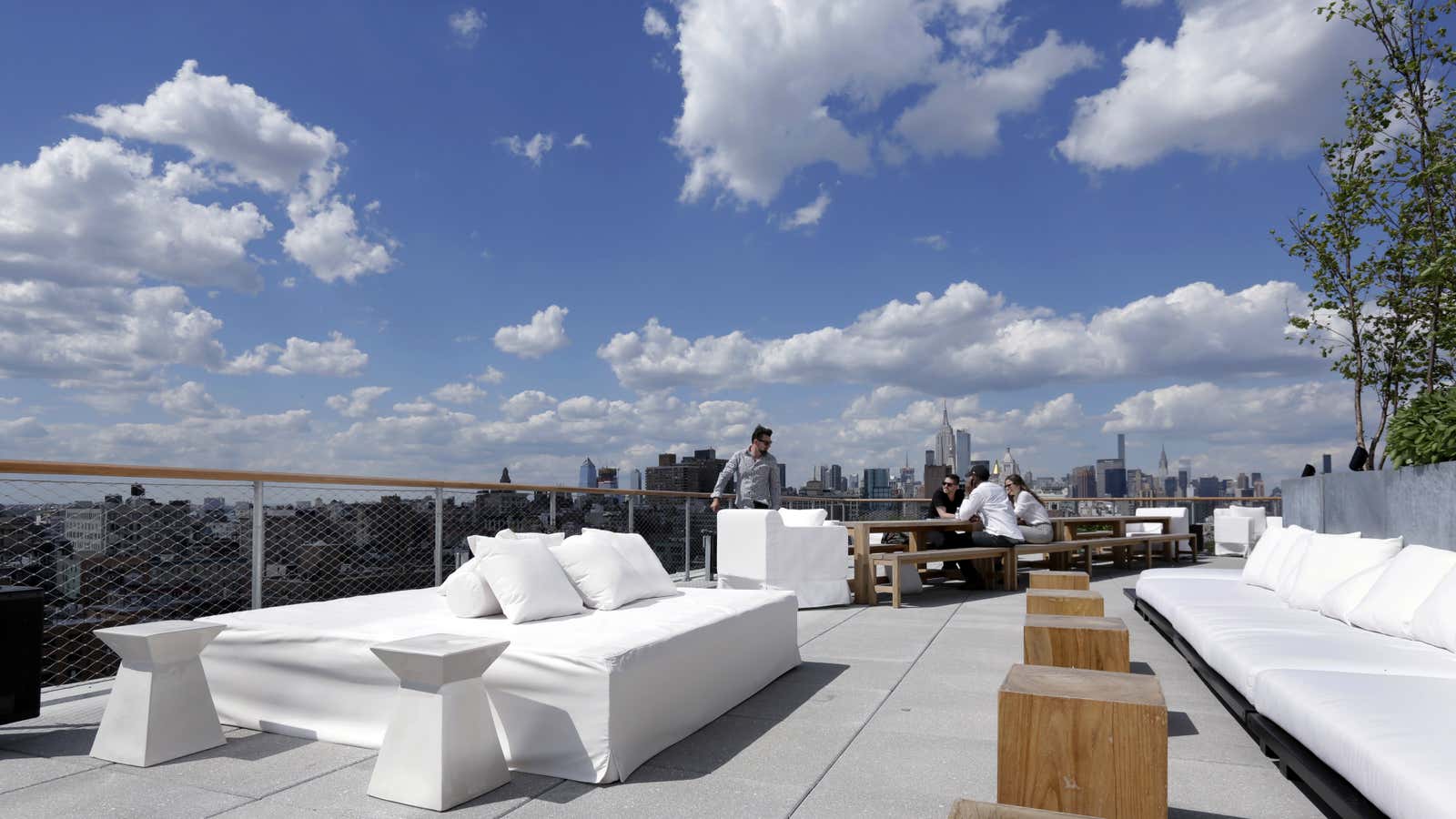If you want some food in your hotel room, chances are you’ll have to put on pants. Pants presentable enough for a walk down to the lobby, where other guests are sipping cappuccinos in lounge chairs, typing away on their laptops. Pants appropriate for the cocktail bar, where a local mixologist is serving up her latest concoction. Pants that are particularly necessary in the first-floor eatery, a cafe that turns into a hip barbecue joint after dark.
For decades, hotel common areas were not designed for congregating. (Just imagine a group meal at the vending machine, or a networking sesh by the ice dispenser.) Noah Silverman, Marriott International’s chief development officer for full-service hotels in North America, says hotel lobbies in particular have long been “pass-through spaces” that resemble “bowling alleys of marble.” But today’s hotels are almost as likely to offer up an actual bowling alley. Hospitality giants like Marriott and Hilton, along with their independent competitors, are ditching room service or other in-room amenities in favor of bright, airy lobbies; communal areas with sweeping views; and bountiful pod seats—all in the hopes of attracting younger, more sociable travelers.

At Ian Schrager’s 370-room Public Hotel—on Manhattan’s Lower East Side, it opened last week with a bash that included a performance by Patti Smith—guests have many options for mingling. Public’s rooftop terrace offer white couches and skyline vistas. There are three bars, including a lobby hangout and nightspot with 360-degree views of the city. Instead of room service guests can pick from two restaurants: a casual eatery with a grab-and-go option, or the main restaurant, Public Kitchen, which has a smoker and a wood-burning grill to cook a menu designed by Jean-Georges Vongerichten. One of the bars, called Diego, also serves a Vongerichten menu. A nightclub and performance space—much like the one that helped earn Virgin Hotels Chicago a Condé Nast Traveler reader’s choice award for best US hotel last year—will offer up comedy shows, theatrical performances, concerts, and film screenings. Wifi is free throughout Public, and a room? Rates start at $150 a night.
Schrager, best known as the co-founder of 1970s hotspot Studio 54, and later, boutique hotels, is one of many hoteliers hoping to capitalize on millennials’ comfort with open-space mingling at work and at home. The replacement of giant in-room hotel desks with shared workspaces mimics the transition from private cubicles to the open-plan office, or from the traditional home office to a laptop and a local cafe. Alexandra Jaritz, who runs Hilton’s new $100ish-a-night Tru brand, says company research found that guests often want these bigger social spaces, even if they aren’t always using them to interact with others. She calls it being “socially alone.”

“There is a concept in sociology of a ‘third space,'” says Sherry Turkle, professor of social studies at the Massachusetts Institute of Technology, who has researched the interaction between technology and social interaction. “It isn’t home but it isn’t someplace we don’t belong. A hotel… is such a place.”
Lavish lobbies and communal workspace do come at a cost: the square footage of guest rooms. Taking a page from hostels’ book, hotels are shrinking the average room, and limiting in-room amenities to just the essentials. Smaller suites mean developers can fit more of them on a single property, and the limited private space drives foot traffic (and wallets) to communal areas for things like food and beer.
A guest room in Marriott’s millennial-geared Moxy brand, for example, is about 186 square feet, compared with 350 square feet for a Marriott-branded property. At Tru hotels, rooms are around 230 square feet, compared with 330 square feet at Hilton’s similarly priced Hampton Inn chain. A Tru lobby common area—referred to as “The Hive” when it launched—is about 3,000 square feet with swing chairs, a big-screen TV, and a free breakfast bar.

At the Sir Adam hotel in Amsterdam, located in the tower that once served as Royal Dutch Shell’s old headquarters, rooms are even tinier—just 160 square feet—but the lobby features colorful hanging swings, a cocktail bar, and stadium seating. Lionel Ohayon, founder and CEO of ICRAVE, which designed the hotel, calls the lobby “a piazza” meant to help travelers ditch the “security blanket” of their phones and other devices.
“Most people live an enormous digital life,” Ohayon says. “People need to be reintroduced to being in public.”
